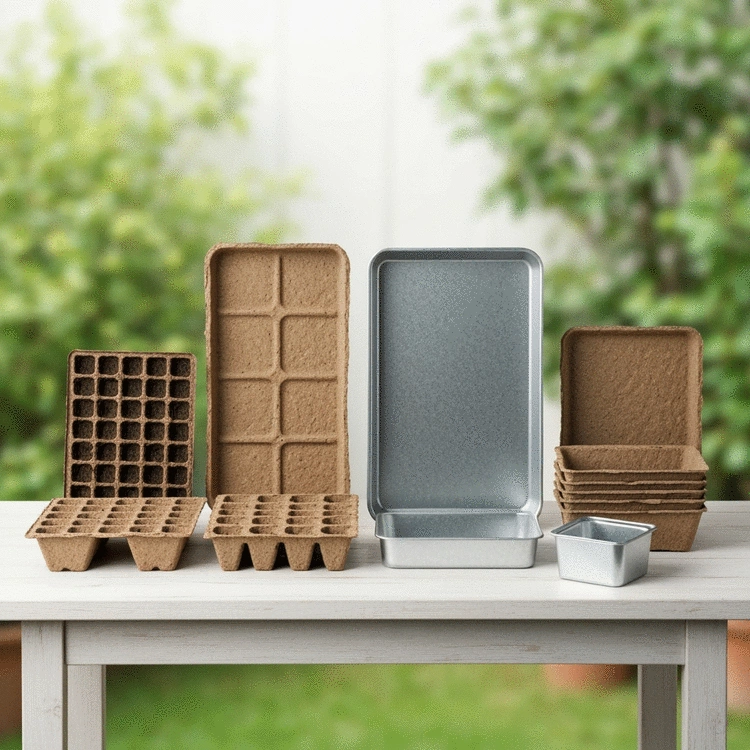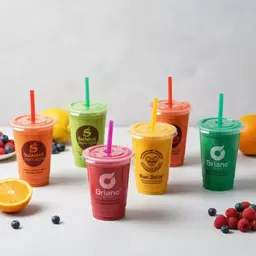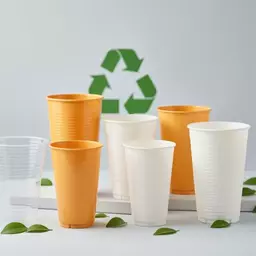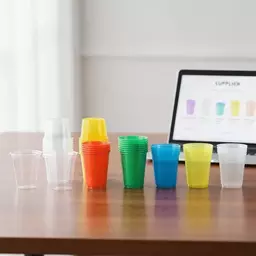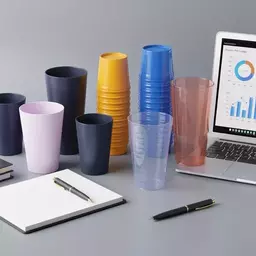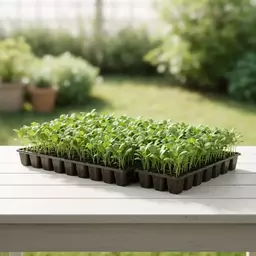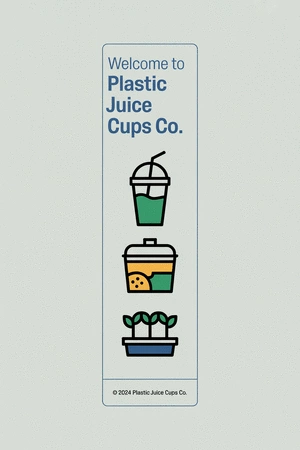Choosing the right seedling trays can be the difference between a flourishing garden and a failed planting attempt. Here's what you need to know to ensure your plants get the best start possible!
What You Will Learn
- Understanding the impact of seedling trays on root development and moisture control.
- The significance of matching tray size to your plant types for optimal growth.
- Key considerations in selecting materials for seedling trays, including plastic and biodegradable options.
- Practical tips for enhancing seedling care, such as watering techniques and soil selection.
Comparing Seedling Tray Materials
This visual highlights the key differences between plastic and biodegradable seedling trays, focusing on their benefits and drawbacks to help you make an informed choice for your gardening needs.
Plastic Seedling Trays
Pros: Durable, reusable, recyclable, can withstand various growing conditions.
Cons: Potential for environmental waste if not recycled properly.
Biodegradable Seedling Trays
Pros: Eco-friendly, enriches soil, clean transplanting (plant directly).
Cons: Limited lifespan, may need more frequent replacement.
Understanding Seedling Trays: An Essential Guide
When it comes to nurturing your plants from tiny seeds to thriving seedlings, selecting the right planting trays is crucial. Seedling trays play a significant role in the growth and development of plants, influencing factors such as root health and moisture retention. Choosing the appropriate materials and sizes can set your plants up for success right from the start!
At Plastic Juice Cups Co., we understand that every gardener has unique needs. That's why we emphasize the importance of understanding the nuances of seedling trays. Not only do they provide the foundation for your plants, but the right choice can also lead to healthier growth and easier transplanting.

Why Choosing the Right Planting Tray Matters
Choosing the right planting tray matters for several reasons:
- Root Development: Proper trays allow roots to grow freely, preventing them from becoming root-bound. For more insights on successful seed starting, you can refer to resources like Carolina Farm Stewards.
- Moisture Control: Some materials retain moisture better than others, which can affect seedling health.
- Size Suitability: Ensuring the tray size matches your plant's needs promotes healthy growth.
The impact of these factors cannot be overstated! A well-chosen seedling tray can mean the difference between a failed planting attempt and a lush garden filled with thriving plants.
Key Factors to Consider When Selecting Seedling Trays
When selecting the perfect seedling trays, several key factors should be considered:
- Material: Different materials offer various benefits, such as durability and biodegradability.
- Size: The size of your tray should correspond to the type of plants you are growing. Detailed information on healthy seedling production can be found in manuals from sources like AVRDC – The World Vegetable Center.
- Cell Count: A higher cell count allows for more plants but requires careful management of nutrients and water.
- Plant Type Compatibility: Some plants thrive in specific environments, so choose trays that match their growth habits.
Understanding these factors helps ensure you make informed decisions that align with your gardening goals. At Plastic Juice Cups Co., we offer a variety of trays designed to meet these needs, ensuring your seedlings get the best start possible!
Exploring Tray Materials: Pros and Cons
Plastic Seedling Trays: Versatile and Durable
Plastic seedling trays are a popular choice among gardeners for good reason! They are known for their versatility and durability, making them ideal for repeated use. Rigid plastic trays can withstand various growing conditions and are often designed to be recyclable, allowing for an eco-friendly approach to gardening.
At Plastic Juice Cups Co., we take pride in offering high-quality plastic trays that stand the test of time. These trays not only support your seedlings but also contribute to sustainability efforts when disposed of properly.
Biodegradable Options: Eco-Friendly Choices
If you're focused on sustainability, biodegradable seedling trays might be the right fit for you. Made from organic materials, such as plant fibers or peat, these trays break down naturally in the soil, enriching it over time. Here are some benefits of using biodegradable trays:
- Reduced Plastic Waste: These trays eliminate the need for plastic disposal.
- Soil Enrichment: As they decompose, they add nutrients back into the soil.
- Clean Transplanting: Biodegradable trays can be planted directly into the ground without disturbing the roots.
Choosing biodegradable options not only helps the environment but also supports a more sustainable gardening practice!
Comparative Analysis of Tray Materials
To help you navigate the various options available, we've created a comparison table summarizing the pros and cons of different seedling tray materials:
| Material | Pros | Cons |
|---|---|---|
| Plastic | Durable, reusable, recyclable | Potential for environmental waste if not recycled |
| Biodegradable | Eco-friendly, enriches soil | Limited lifespan; may need to be replaced more often |
Understanding these materials will empower you to make the best choice for your gardening endeavors! With the right information, you can select trays that not only suit your plants' needs but also align with your values.
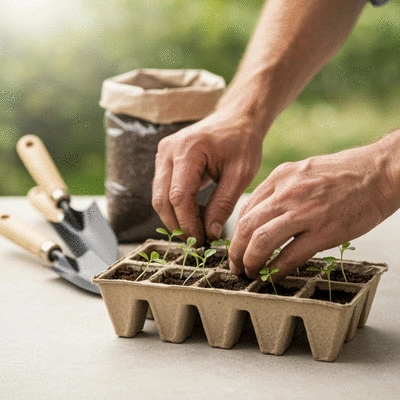
Interactive Poll: Your Seedling Tray Choice
We want to know what type of seedling trays you prefer! Do you lean towards the durability of plastic, or do you opt for the eco-friendly appeal of biodegradable options? Share your thoughts below:
Frequently Asked Questions About Seedling Trays
- What is the most important factor when choosing a seedling tray?
- The most important factors are matching the tray size to your plant's needs, considering the material (plastic for durability, biodegradable for sustainability), and ensuring proper drainage and moisture control for healthy root development.
- What are the benefits of using plastic seedling trays?
- Plastic seedling trays are known for their durability, reusability, and versatility. They can withstand various growing conditions and are often recyclable, making them a cost-effective choice for repeated use.
- Why should I consider biodegradable seedling trays?
- Biodegradable seedling trays are an eco-friendly option that reduces plastic waste. They enrich the soil as they decompose and allow for clean transplanting directly into the ground without disturbing the plant's roots.
- How does tray size impact seedling growth?
- The right tray size prevents roots from becoming root-bound and ensures adequate space for healthy growth. Different plants have different space requirements, so matching the tray size to the plant type is crucial for optimal development.
- What are some key tips for seedling care and growth optimization?
- Key tips include maintaining consistently moist (but not waterlogged) soil, providing adequate light (natural or grow lights), and using a well-draining potting mix. Regular cleaning and maintenance of trays also promote seedling health and longevity.
Summarizing Key Takeaways for Choosing Seedling Trays
As we wrap up our discussion on seedling trays, it’s important to remember that selecting the right materials, sizes, and care practices is crucial for ensuring successful seedling growth. Each component plays a significant role in the development of your plants, so taking the time to evaluate your options will pay off in the long run.
By understanding the various types of trays available, you can make informed choices that cater to your specific gardening needs. Whether you're using plastic, biodegradable, or any other materials, your choice should align with your gardening goals and sustainability values.
- Material Matters: Choose between plastic and biodegradable options based on durability and environmental impact.
- Size Selection: Match tray sizes to your plant types for optimal growth.
- Care Techniques: Regularly clean and maintain trays to promote health and longevity.
Keeping these takeaways in mind will undoubtedly lead to healthier seedlings and more productive gardening experiences!
Taking the Next Steps in Your Gardening Journey
Now that you have a solid understanding of seedling trays, I encourage you to evaluate your options based on your specific planting needs and the types of plants you wish to grow. Don’t hesitate to reach out with any questions or share your experiences with seedling trays—after all, we’re in this gardening journey together!
As you explore different products, consider how the various trays from Plastic Juice Cups Co. can meet your unique requirements. Our expertise in crafting high-quality planting trays ensures that you have access to reliable and sustainable solutions.
Visual Aids for Better Understanding
To further enhance your understanding of seedling trays, I recommend referring to accompanying visuals such as charts or infographics. These can help you visualize tray sizes and their suitability for different plants. Remember, a picture is worth a thousand words!
- Infographics showcasing tray dimensions and plant compatibility.
- Charts comparing the benefits of various materials.
- Visual guides on proper care and maintenance practices.
These resources will be invaluable in helping you make informed decisions as you embark on your planting journey!
Tips for Seedling Care and Growth Optimization
To ensure your seedlings thrive, consider these practical tips on watering techniques, light conditions, and soil types:
- Watering: Keep the soil consistently moist but not waterlogged to avoid root rot.
- Light Conditions: Provide adequate sunlight or use grow lights for optimal growth.
- Soil Types: Choose a well-draining potting mix that supports root development. Additional guidance on the care and transportation of seedlings can be found at the Montana Department of Natural Resources and Conservation.
Implementing these practices will significantly enhance seedling health and promote strong root systems!
Exploring Indoor and Outdoor Planting Strategies
Lastly, let’s discuss the differences in seed starting for indoor gardening versus outdoor planting. Indoor gardening allows for more controlled conditions, while outdoor planting requires you to consider the local climate and seasonal changes.
- Indoor Planting: Focus on light and temperature control to create a nurturing environment.
- Outdoor Planting: Timing is key! Ensure you transplant seedlings after the last frost and consider the sun exposure of your garden.
Understanding these strategies will help you choose the right approach based on your gardening goals. Happy planting! 🌱
Recap of Key Points
Here is a quick recap of the important points discussed in the article:
- Material Matters: Choose between plastic and biodegradable options based on durability and environmental impact.
- Size Selection: Match tray sizes to your plant types for optimal growth.
- Care Techniques: Regularly clean and maintain trays to promote health and longevity.
- Moisture Control: Select trays that retain moisture effectively to support seedling health.
- Plant Type Compatibility: Ensure trays are suitable for the specific growth habits of your plants.
